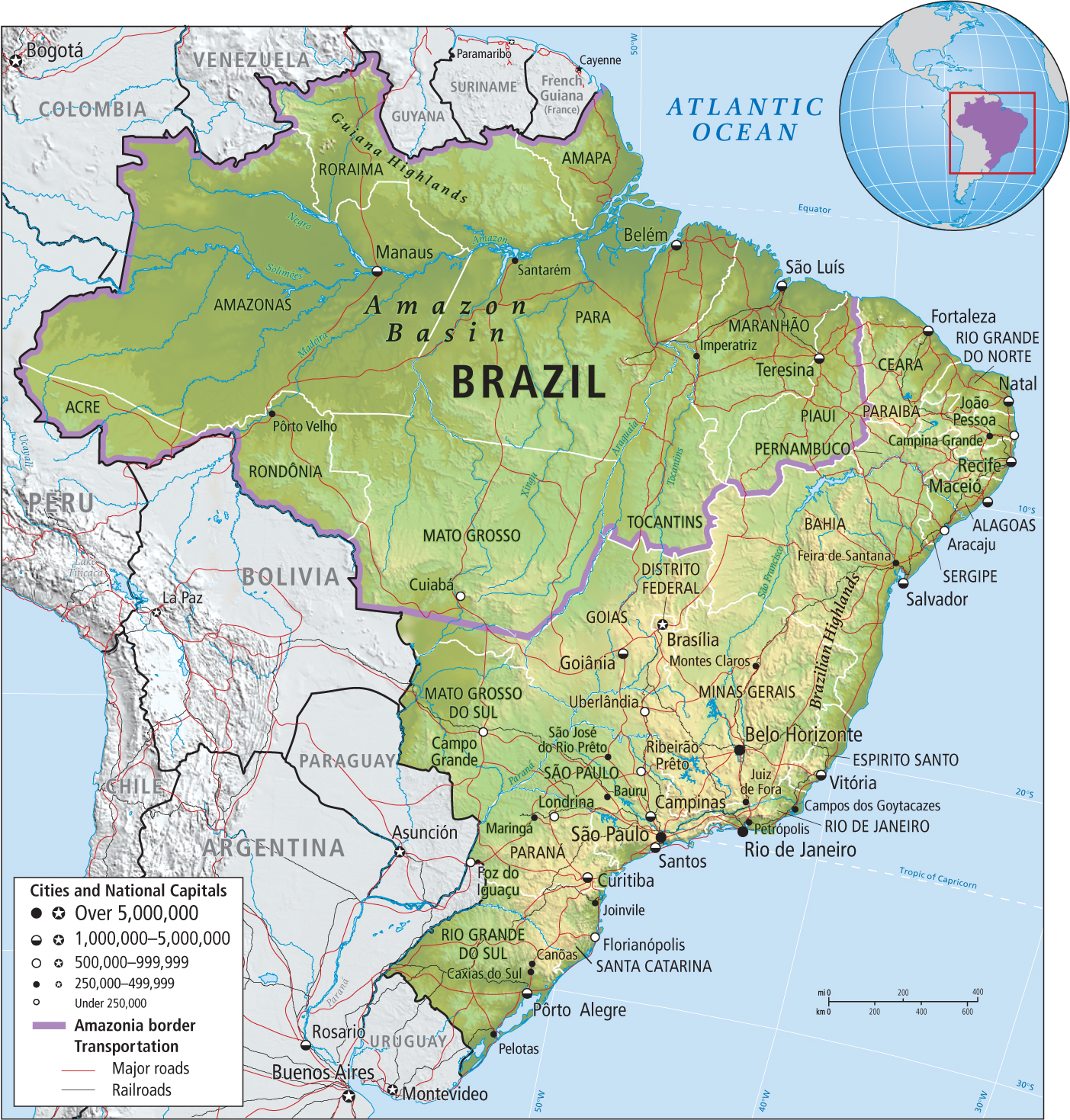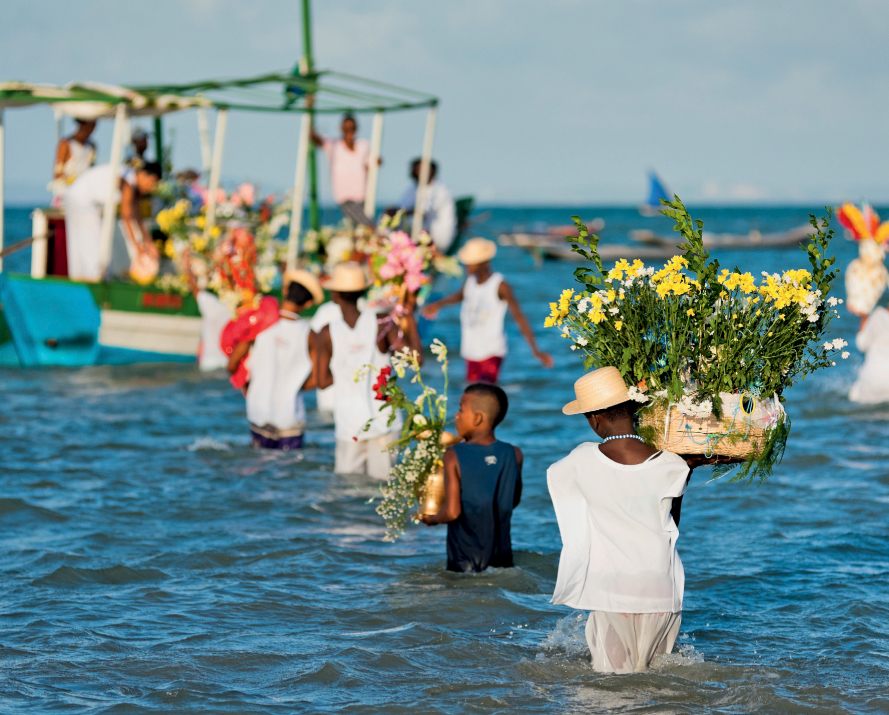Brazil
The observant visitor to Brazil is quickly caught up in the country’s physical complexity and in the richly exuberant, sleekly modern, multicultural quality of its society (Figure 3.39). But its landscapes also plainly show the environmental effects of both colonialism and recent underplanned economic development. Brazil’s 197 million people live in a highly stratified society made up of a small, very wealthy elite; a modest but rising middle class; and a majority that lives below, or just barely above, the poverty line. In Brazil’s megacities of São Paulo and Rio de Janeiro, elegant high-rise buildings are surrounded by vast favelas (see Figure 3.27). High crime rates and homeless street children are signs of the gross inequities in opportunity and well-being. According to the latest figures (2007), the richest 10 percent of Brazil’s population has 41 times the wealth of the poorest 10 percent. This remains one of the widest disparities in Middle and South America and the world, yet it shows a 25-point improvement over the last decade (see Table 3.2). Travelers find themselves delighted by the flamboyant creativity and elegance of the Brazilian people, yet sobered by the obvious hardships under which so many labor.

Brazil’s Size and Varied Topography
Brazil has about the same area as the United States. Its three distinctive physical features are the Amazon Basin, the Mato Grosso, and the Brazilian Highlands. The Amazon Basin, which covers the northern two-thirds of the country, is described (see also Figures 3.1 and 3.4). The Mato Grosso is a seasonally wet/dry interior lowland south of the Amazon with a convoluted surface. Once covered with grasses and scrubby trees adapted to long dry periods, in the twentieth century it was extensively cleared for subsistence and commercial agriculture. The southern third of Brazil is occupied mostly by the Brazilian Highlands, a variegated plateau that rises abruptly just behind the Atlantic seaboard 500 miles (800 kilometers) south of the mouth of the Amazon. The northern portion of the plateau is arid; the southern part receives considerably more rainfall. Settlement in northeastern Brazil is concentrated in a narrow band along the Atlantic seaboard and south through the city of Salvador (see Figure 3.25B). In Brazil’s temperate zone, near Rio de Janeiro, São Paulo, Curitiba, and Pôrto Alegre, settlement extends deeper inland (see Figure 3.20).
Managing Brazil’s Large and Varied Economy
The Brazilian economy is the largest in Middle and South America and the eighth largest in the world. The resources available for development in Brazil are the envy of most nations, but management of those resources and the development of infrastructure to serve Brazil’s best interests has been a challenge. Brazil long looked to the Amazon for its future development but successive governments failed to recognize the fragility of Amazonian ecosystems (see the discussion) and the hidden costs of development. As a result, one of the world’s largest tropical forests has been degraded and many poor settlers have been misled.
Gold, silver, and precious gems have been important resources since colonial days, but it is industrial minerals—chromite, manganese, rare earths, titanium, tungsten, and especially iron ore—that are most valuable today. These minerals are found in many parts of the Brazilian Highlands, where they are mined with insufficient attention to human and environmental consequences. Hydroelectric power is widely available because of the many rivers and natural waterfalls that descend from the highlands, but electricity distribution remains highly unequal.
Local oil now provides for 60 percent of Brazil’s needs, and more is being accessed offshore in the Atlantic and also west of Manaus in the Amazon. A large part of the remainder of Brazil’s energy needs are supplied by ethanol, which in Brazil is made from commercially grown sugarcane in a system that is precisely engineered for efficiency in terms of energy used to energy produced. Brazil now makes cars that can instantly switch from gas to ethanol and get 40 miles to the gallon.
Brazil has had large-scale, labor-intensive agriculture for 400 years. Today, the agricultural picture varies: horticultural farming of fruits and vegetables in the south; large, increasingly mechanized, commercial farms growing primarily sugarcane, tobacco, cotton, cassava, and oil palm in the northeast; and ranching in the interior dry zones. Production of soybeans, pork, and beef has some potential to expand in the Mato Grosso, but most of Brazil’s available land is in the tropical Amazon, where soils are fragile. There, agriculture and timber extraction are expanding rapidly at the expense of tropical rain forests. Thousands of square miles of forest fall yearly for the cultivation of such crops as soybeans and pasture grass. Overall, agricultural exports from Brazil are increasing and exceed imports, but as a proportion of Brazil’s GDP, agriculture (5.5 percent) is rapidly losing out to industry (27.5 percent) and services (67 percent).
Brazil is the most highly industrialized country in South America, and its global role is expanding. Most of its industries—steel, motor vehicles, aeronautics, appliances, chemicals, textiles, and shoes—are concentrated in a triangle formed by the huge southeastern cities of São Paulo, Rio de Janeiro, and Belo Horizonte. Yet the country’s transportation system (modernized roads, airports, and rail connections) are still far from adequate, though officials claim that the Olympic games to be in Rio in 2016 will force rapid upgrading.  60. BRAZIL MAKES HIGH-PROFILE INVESTMENT IN U.S.
60. BRAZIL MAKES HIGH-PROFILE INVESTMENT IN U.S.
Until the 1990s, the vast majority of Brazil’s mining and industrial operations were developed using government funding. Many are still owned and run by the government, but some are successful private enterprises. In the 1980s and 1990s, elected governments adopted structural adjustment policies and privatized many formerly government-held industries and businesses in an effort to make them more efficient. Many of these firms were sold to foreign investors at bargain-basement prices. In 2000 alone, direct foreign investors spent $32.8 billion on Brazilian properties. Privatizing industry often results in greater productivity, and indeed, beginning in 2001, exports began to exceed imports. By 2011, exports were $250 billion and imports $219 billion. The sale of state-owned industries, however, may have hurt Brazil in the long run, because environmental regulations on these firms are lax and because any profits that might materialize will go not to the public, who paid for the development of these industries, but to the new private owners, who may well invest those profits outside Brazil.
Urbanization
Brazil has a number of large and well-known cities: Rio de Janeiro, Curitiba, São Paulo, Salvador, Recife, Fortaleza, Belém, Manaus, and Brasília. All except Manaus and Brasília are located on the Atlantic perimeter of the country. During the global economic depression of the 1930s, farmworkers throughout the country began migrating into urban areas as world prices for Brazil’s agricultural exports fell; agricultural changes in the 1960s pushed even more people off the land and the chance for employment in the factories that were being built with government money pulled them into the cities. Brazil’s competitive edge in the global market was its cheap labor. The military governments of the time, thinking that the mostly government-owned industries should continue to pay very low wages because there was such a surplus of workers, found that they had to quell many protests by workers who could not live decently on their wages.
By 2011, eighty-seven percent of Brazil’s population was urban, and at least one-third of the urban dwellers, many of them underemployed, were living in favelas, the Brazilian urban shantytowns (see Figure 3.27). The poverty in the hardest-hit cities in the northeast rivals that of Haiti, the poorest country in the Americas. Brazilians, however, are intrepid at finding ways to make life worth living. Favela dwellers are famous for their efforts to create strong community life and support for those in distress. Many turn to music, dance performance, and religion of one sort or another as a source of strength.
VIGNETTE
It’s Friday afternoon, and a crowd of white-clad women is gathering outside a house in the Felicidad favela in Fortaleza. Like the surrounding houses, this one is modest, but it gleams white; all its surfaces are swathed in marble. Potted palms decorate the porch, and beside them, welcoming the women, is a tall, elegant middle-aged man also dressed in white, a religious leader in the movement known as Umbanda. Umbanda, Batuque, and related belief systems thrive in all the Atlantic coastal cities of Brazil from Belém to São Paulo (Figure 3.40). Each group is led by a male or female spiritual leader who invokes the spirits to help people cope with health problems and the ordinary stresses and strains of a life of urban poverty. During the ceremonies, which can last as long as 8 hours, the central focus is a combination of drumming, dancing, spirit possession, and friendly psychological support. Umbanda grew out of an older African-Brazilian belief system called Candomblé, and similar movements (Voodoo, Santería, Obeah) are found elsewhere in the Americas, including the Caribbean, the United States, and Canada. In Brazil, Umbanda appeals to an increasingly wide spectrum of the populace from African, European, Asian, and indigenous backgrounds. [Source: Lydia Pulsipher’s field notes.] 

Courtesy Jan Sochor/Latincontent/Getty Images
Brasília
forward capital a capital city built in the hinterland to draw migrants and investment for economic development and sometimes for political/strategic reasons
Over five decades of actually using this urban landscape, people have made all sorts of interesting changes to the formal design. At the Parliament, legislative staff and messengers created footpaths where they needed them: through flowerbeds and—with little steps notched in the dirt—up and over landscaped banks. Thus they efficiently connected the administration buildings, bypassing the sweeping promenades. Little hints of the informal economy that characterizes life in the old cities of Brazil began to show up—a fruit vendor here, a manicurist there. And the shantytowns that the planners had tried hard to eliminate began to rise relentlessly around the perimeter. Overall, in the 50 years since its construction, Brasília’s success as a forward capital and growth pole has been limited. Although the city has drawn poor laborers, the entire province of Goiás still has only 4.5 million people, just 6 percent of the country’s total, and their average income is only half that of the country as a whole. Population and investment remain centered in the Atlantic coastal cities.
THINGS TO REMEMBER
 Brazil, about the size of the United States and home to the Amazon Basin, has suffered rather severe environmental degradation due to large-scale logging, industrial farms, and mining.
Brazil, about the size of the United States and home to the Amazon Basin, has suffered rather severe environmental degradation due to large-scale logging, industrial farms, and mining. Brazil has a highly urbanized population (more than 80 percent of the people live in urban areas). Many live in difficult circumstances in favelas.
Brazil has a highly urbanized population (more than 80 percent of the people live in urban areas). Many live in difficult circumstances in favelas. Signs are hopeful that Brazil will continue its present trajectory of positive development and its emergence as a world leader.
Signs are hopeful that Brazil will continue its present trajectory of positive development and its emergence as a world leader.